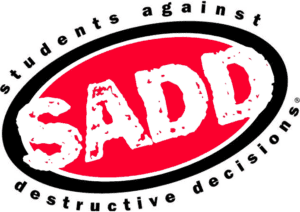 Over the past 35 years, hundreds of thousands of US and international high schools have established SADD (Students Against Destructive Decisions) club chapters. Created in 1981 by Robert Anastas as “Students Against Drunk Driving”, SADD originally intended to inspire students to stop driving under the influence of drugs or alcohol and consequentially reduce the high rate of car accidents caused from doing so. Today, however, SADD has broadened its mission to encompass not just driving under the influence but also other destructive decisions often made by teens such as substance abuse, violence, suicide, eating disorders, and other issues of mental health. As stated on their website, SADD’s mission is to, “Use students themselves as primary agents and meaningful contributors [in order to] become the premier youth-based education and prevention organization in America and maintain the ability to play a leading role in effective, evidence-based prevention programming.”
Over the past 35 years, hundreds of thousands of US and international high schools have established SADD (Students Against Destructive Decisions) club chapters. Created in 1981 by Robert Anastas as “Students Against Drunk Driving”, SADD originally intended to inspire students to stop driving under the influence of drugs or alcohol and consequentially reduce the high rate of car accidents caused from doing so. Today, however, SADD has broadened its mission to encompass not just driving under the influence but also other destructive decisions often made by teens such as substance abuse, violence, suicide, eating disorders, and other issues of mental health. As stated on their website, SADD’s mission is to, “Use students themselves as primary agents and meaningful contributors [in order to] become the premier youth-based education and prevention organization in America and maintain the ability to play a leading role in effective, evidence-based prevention programming.”
Despite the fact that this mission is undoubtedly a positive one intended to provide students with a peer support system and prevent destructive behaviors, certain chapters, including the one that existed at my own high school, have shut down. Why? Well, the answer is by no means a simple one. Although I am sure some simply closed due to a lack of participation or funding, the reason at my all-girls intercity private school was far more multifaceted.
Picture this scenario: Two teenage girls – let’s call them Jane and Sally – attend an elite, high intensity private school where they constantly struggle to keep up academically. Although none of their friends have much of a social life, they feel that the best way to escape the confinement of their academically driven surroundings is to turn to alcohol. However, because of the lacking party culture and discussion of alcohol at their high school, the girls find themselves needing some outlet to broach the subject within their community. So, they decide to start a SADD chapter. Jane tells Sally that it would be kind of funny for them to be the ones running the club when they are the only two in their grade who even make so-called “destructive decisions” – which they both laugh at – and Sally tells Jane that being a three-year club head would be a sure bonus on their college applications anyway. They find an overworked teacher with a laissez-faire supervision attitude to be the club advisor and then take full liberty to introduce the culture of alcohol and drugs to their peers via their new “hip” club.
But here’s the problem. Sure, now the school has a SADD chapter through which students like Jane and Sally could hypothetically receive help and support, but, in reality, all it is doing is serving as a place for these girls to mock anyone who doesn’t partake in alcohol-related activities and encourage their behavior to others. In essence, the club is serving the counter-purpose to SADD’s mission: it is encouraging “destructive decisions.”
Although it took about a year, my school eventually recognized the ineffectiveness of our SADD chapter and shut it down on the grounds that it was poorly run and harmful to the community. In fact, similar complaints about SADD have been present ever since its founding. Just after the program’s initial conception, critics argued that its attempts to prevent drinking and driving actually condoned drinking by young people. This led some schools to refuse to start chapters and certain agencies to refuse to provide funding. Like the issues my school took with the SADD club of today, these historical qualms are rooted in concerns that SADD was actually serving a reverse purpose. SADD as an organization, however, has been very open to change and adaptations when such concerns arise. In fact, the catalyst for their name change from “Students Against Drunk Driving” to “Students Against Destructive Decisions” arose from the criticism of the 80s and early 90s about the ineffectiveness of their original message.
Looking at SADD as an institution, it is clear that their goals, mission, and adaptability are more than worthwhile. However, it does seem that the student leadership – which determines the success of individual chapters – is particularly susceptible to failure. And, sadly, failed student leadership undermines the ability of the mission to reach its fullest potential.
So, what we are left with are a variety of questions. Was my school, and other’s like it, right to close down their SADD chapter? Will the SADD of today take this as a sign that something needs to shift within their organization in order to most effectively convey their message and reach teens across the world? Is there even a good way to address the issues inherent in the actions of students like Jane and Sally? Should schools keep SADD at all?
Works Referenced:
-http://www.sadd.org/who-we-are/our-approach/
-http://www.encyclopedia.com/doc/1G2-3403100433.html

